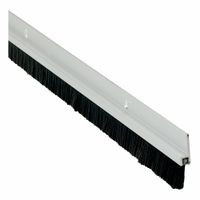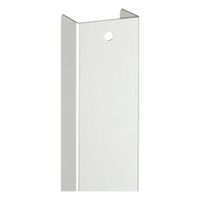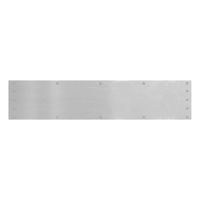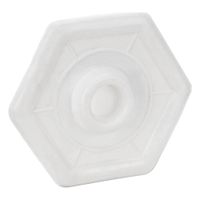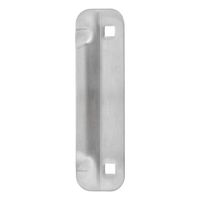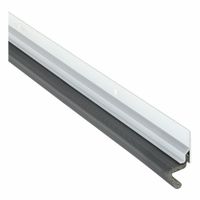Call +(254) 703 030 000 / 751 483 999 / 721 704 777
- Home
- Hardware
- Door Hardware
- Door Guards Sweeps And Weatherstripping
.....Read More
Frequently Asked Questions
What is the best type of door sweep for preventing drafts and pests?
The best type of door sweep for preventing drafts and pests is the combination door sweep, which typically features a metal strip with a rubber or vinyl insert. This design provides a dual-action barrier that effectively seals gaps at the bottom of the door. The metal strip offers durability and stability, while the flexible insert conforms to the floor surface, ensuring a tight seal that blocks air drafts and deters pests.
Combination door sweeps are versatile and can be used on a variety of door types, including exterior doors, which are most susceptible to drafts and pest intrusion. The rubber or vinyl insert is resistant to wear and tear, maintaining its effectiveness over time even with frequent door use. Additionally, these materials are often weather-resistant, making them suitable for different climates and conditions.
Installation is straightforward, typically involving screws or adhesive strips, and the sweep can be adjusted to fit the specific gap under the door. This adjustability ensures that the sweep maintains contact with the floor, maximizing its sealing capability.
For optimal performance, it's important to choose a door sweep that matches the specific needs of your environment. For instance, if you live in an area with extreme weather conditions, a heavy-duty rubber insert may be preferable. Similarly, if pest control is a primary concern, ensure the sweep is tightly fitted to prevent even the smallest insects from entering.
Overall, the combination door sweep is a cost-effective and efficient solution for enhancing energy efficiency and maintaining a pest-free environment.
How do I install weatherstripping on a door to improve insulation?
1. **Choose the Right Weatherstripping**: Select the appropriate type for your door. Common types include adhesive-backed foam tape, V-strip (tension seal), door sweeps, and tubular rubber, vinyl, or silicone.
2. **Measure the Door**: Measure the top, sides, and bottom of the door frame to determine how much weatherstripping material you need.
3. **Clean the Surface**: Thoroughly clean the door frame and the door itself where the weatherstripping will be applied. Use a mild detergent and water, then dry completely to ensure proper adhesion.
4. **Install on the Sides and Top**:
- **Foam Tape or V-Strip**: Cut the weatherstripping to the length of the door frame. Peel off the backing and press it firmly along the sides and top of the door frame.
- **Tubular Rubber/Vinyl/Silicone**: These often come with a metal or plastic strip. Cut to size, then nail or screw the strip to the door frame, ensuring the tube compresses slightly when the door is closed.
5. **Install the Door Sweep**:
- Measure and cut the sweep to fit the width of the door.
- Attach it to the bottom of the door using screws or adhesive, ensuring it lightly touches the threshold to block drafts.
6. **Test the Door**: Open and close the door to ensure it seals properly without hindering movement. Adjust as necessary.
7. **Check for Gaps**: Inspect for any remaining gaps and apply additional weatherstripping if needed.
8. **Maintenance**: Periodically check the weatherstripping for wear and replace it as necessary to maintain insulation efficiency.
What are the benefits of using a door kick plate?
A door kick plate is a protective sheet, typically made of metal, plastic, or wood, installed at the bottom of a door. It offers several benefits:
1. **Protection**: Kick plates shield the lower part of the door from damage caused by foot traffic, carts, or equipment. This is especially useful in high-traffic areas like commercial buildings, hospitals, and schools.
2. **Durability**: By preventing scratches, dents, and scuffs, kick plates extend the life of the door, reducing the need for frequent repairs or replacements.
3. **Aesthetic Appeal**: Available in various materials and finishes, kick plates can enhance the visual appeal of a door, complementing the overall design and style of a space.
4. **Cost-Effective**: Installing a kick plate is a relatively inexpensive way to protect doors, saving money in the long run by minimizing maintenance and replacement costs.
5. **Ease of Installation**: Kick plates are easy to install, often requiring just a few screws or adhesive, making them a convenient option for both new and existing doors.
6. **Hygiene**: In environments where hygiene is crucial, such as hospitals or kitchens, kick plates can help maintain cleanliness by reducing the need to touch the door with hands.
7. **Customization**: Kick plates can be customized with logos, patterns, or colors, allowing businesses to incorporate branding or design elements into their door hardware.
8. **Safety**: In emergency situations, kick plates can help prevent doors from sticking or jamming by protecting the lower edge from damage.
Overall, door kick plates are a practical and versatile solution for protecting doors, enhancing aesthetics, and improving functionality in various settings.
How can door latch guards enhance security against break-ins?
Door latch guards enhance security against break-ins by providing a physical barrier that protects the latch or deadbolt area of a door. These guards are typically made of strong materials like steel or heavy-duty metal, making it difficult for intruders to tamper with the locking mechanism. By covering the gap between the door and the frame, latch guards prevent tools like crowbars or credit cards from being inserted to manipulate the latch or deadbolt. This added layer of protection is especially effective against forced entry techniques such as prying or kicking, which are common methods used by burglars.
Latch guards also deter lock picking and other forms of lock manipulation by obstructing access to the lock itself. They are designed to fit snugly over the latch area, making it challenging for intruders to reach the lock with picking tools. Additionally, some latch guards come with anti-tamper features, such as security screws that cannot be easily removed, further enhancing their effectiveness.
Moreover, door latch guards can be used on both residential and commercial properties, providing versatile security solutions. They are relatively easy to install and can be added to existing doors without significant modifications. By reinforcing the most vulnerable part of a door, latch guards serve as a cost-effective measure to improve overall security and deter potential break-ins.
In summary, door latch guards enhance security by physically protecting the latch or deadbolt area, preventing unauthorized access, and deterring common break-in techniques. Their robust construction and anti-tamper features make them a valuable addition to any security system, providing peace of mind to property owners.
What is the process for installing a door bottom to block out elements?
1. **Measure the Door Width**: Use a tape measure to determine the width of the door. This will help you select the correct size for the door bottom.
2. **Select the Door Bottom**: Choose a door bottom that suits your needs. Options include sweep, under-door, or combination types. Ensure it is weather-resistant to block out elements like drafts, water, and pests.
3. **Gather Tools and Materials**: You will need a screwdriver, drill, screws, a saw (if trimming is necessary), and the door bottom.
4. **Remove the Door (if necessary)**: For easier installation, you may need to remove the door from its hinges. Use a screwdriver to take out the hinge pins and carefully set the door aside.
5. **Trim the Door Bottom**: If the door bottom is too long, use a saw to trim it to the correct width. Follow the manufacturer's instructions for cutting.
6. **Position the Door Bottom**: Align the door bottom with the bottom edge of the door. Ensure it is centered and level.
7. **Mark Screw Holes**: Use a pencil to mark where the screws will go. Most door bottoms have pre-drilled holes for guidance.
8. **Drill Pilot Holes**: Use a drill to create pilot holes at the marked spots. This prevents the wood from splitting when you insert the screws.
9. **Attach the Door Bottom**: Secure the door bottom to the door using screws. Tighten them with a screwdriver or drill, ensuring the door bottom is firmly attached.
10. **Rehang the Door**: If you removed the door, reattach it to the hinges. Ensure it swings freely and the door bottom seals properly against the threshold.
11. **Test the Seal**: Close the door and check for gaps. Adjust if necessary to ensure a tight seal against the elements.
How do door edge and frame guards protect against wear and tear?
Door edge and frame guards protect against wear and tear by providing a physical barrier that absorbs impact and prevents direct contact between the door or frame and potentially damaging elements. These guards are typically made from durable materials such as rubber, plastic, or metal, which are designed to withstand repeated use and environmental factors.
When a door is opened or closed, it can come into contact with walls, furniture, or other objects, leading to scratches, dents, or chips. Door edge guards cover the vulnerable edges of the door, preventing these types of damage. They also help in maintaining the door's aesthetic appeal by keeping it free from unsightly marks and prolonging its lifespan.
Frame guards, on the other hand, protect the door frame from similar damage. They are particularly useful in high-traffic areas where doors are frequently used, such as in commercial buildings or busy households. By absorbing the impact of the door closing or being pushed open, frame guards reduce the risk of structural damage to the frame, which can lead to costly repairs or replacements.
Additionally, these guards can help in reducing noise by cushioning the impact when a door is closed, contributing to a quieter environment. They also provide a level of protection against moisture and temperature changes, which can cause warping or swelling in wooden doors and frames.
Overall, door edge and frame guards are a cost-effective solution to prevent wear and tear, ensuring the longevity and functionality of doors and frames while maintaining their appearance.
What are the advantages of using door hole covers and filler plates for lock reinforcement?
Door hole covers and filler plates offer several advantages for lock reinforcement:
1. **Enhanced Security**: They provide an additional layer of protection against forced entry by covering unused lock holes, reducing potential weak points that intruders might exploit.
2. **Aesthetic Improvement**: These covers help maintain a clean and uniform appearance on doors by concealing unsightly holes left from previous lock installations or modifications.
3. **Cost-Effective Solution**: Instead of replacing an entire door to address security concerns or aesthetic issues, using door hole covers and filler plates is a more economical option.
4. **Versatility**: They are available in various sizes and finishes, allowing them to match different door types and styles, ensuring compatibility with existing door hardware.
5. **Easy Installation**: Most door hole covers and filler plates are designed for straightforward installation, often requiring minimal tools and effort, making them accessible for DIY projects.
6. **Durability**: Made from robust materials like metal or heavy-duty plastic, these covers are designed to withstand wear and tear, contributing to long-term door integrity.
7. **Weather Protection**: By sealing unused holes, they help prevent drafts, moisture, and pests from entering through gaps, enhancing the door's insulation properties.
8. **Flexibility for Future Modifications**: They allow for easy future modifications or upgrades to door hardware without the need for extensive repairs or replacements.
9. **Compliance with Building Codes**: In some regions, using filler plates can help meet building codes or insurance requirements by ensuring that doors are properly secured and maintained.
10. **Noise Reduction**: By covering holes, they can also contribute to reducing noise transmission through doors, enhancing privacy and comfort within a space.
